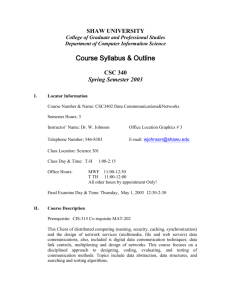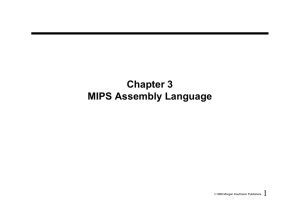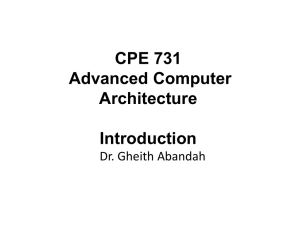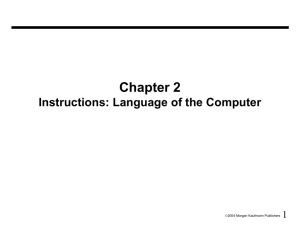Chapter 3 MIPS Instructions
advertisement
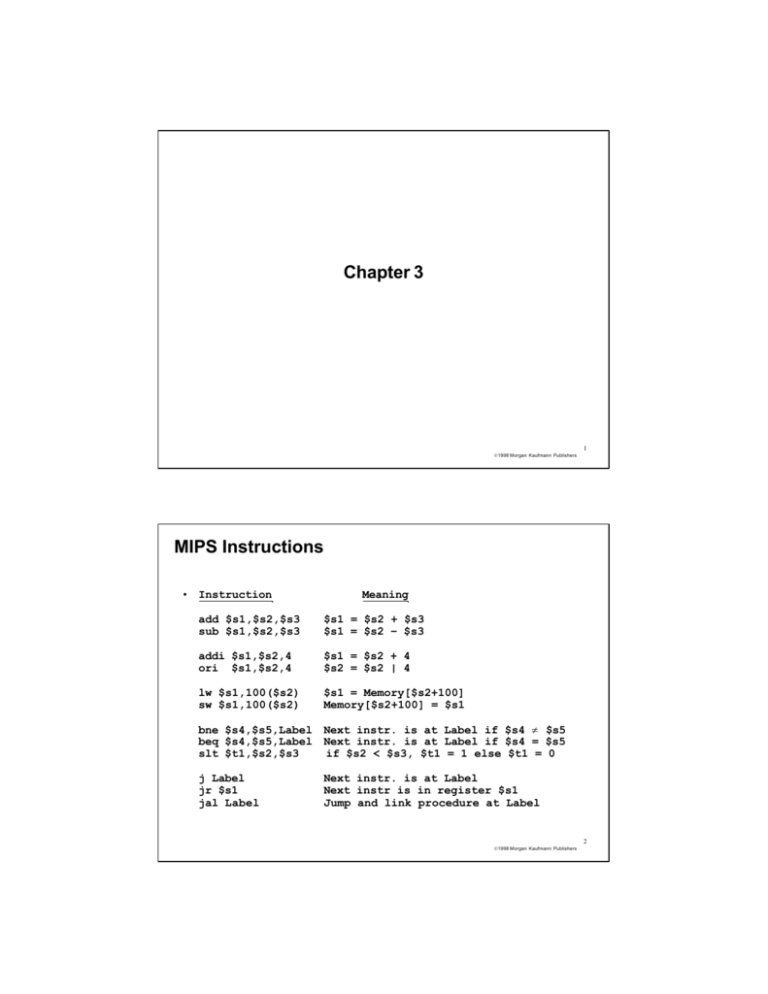
Chapter 3 1 1998 Morgan Kaufmann Publishers MIPS Instructions • Instruction Meaning add $s1,$s2,$s3 sub $s1,$s2,$s3 $s1 = $s2 + $s3 $s1 = $s2 – $s3 addi $s1,$s2,4 ori $s1,$s2,4 $s1 = $s2 + 4 $s2 = $s2 | 4 lw $s1,100($s2) sw $s1,100($s2) $s1 = Memory[$s2+100] Memory[$s2+100] = $s1 bne $s4,$s5,Label Next instr. is at Label if $s4 ≠ $s5 beq $s4,$s5,Label Next instr. is at Label if $s4 = $s5 slt $t1,$s2,$s3 if $s2 < $s3, $t1 = 1 else $t1 = 0 j Label jr $s1 jal Label Next instr. is at Label Next instr is in register $s1 Jump and link procedure at Label 2 1998 Morgan Kaufmann Publishers Assembly Language vs. Machine Language • Assembly provides convenient symbolic representation – much easier than writing down numbers – e.g., destination first • Machine language is the underlying reality – e.g., destination is no longer first • Assembly can provide 'pseudoinstructions' – e.g., “move $t0, $t1” exists only in Assembly – would be implemented using “add $t0,$t1,$zero” 3 1998 Morgan Kaufmann Publishers Stored Program Concept • • Instructions are bits Programs are stored in memory — to be read or written just like data Processor • Memory memory for data, programs, compilers, editors, etc. Fetch & Execute Cycle – Instructions are fetched and put into a special register – Bits in the register "control" the subsequent actions – Fetch the “next” instruction and continue 4 1998 Morgan Kaufmann Publishers Instruction Set Architecture: What Must be Specified? Instruction Fetch Instruction Decode Operand Fetch Execute Result Store Next Instruction ° Instruction Format or Encoding – how is it decoded? ° Location of operands and result – where other than memory? – how many explicit operands? – how are memory operands located? – which can or cannot be in memory? ° Data type and Size ° Operations – what are supported ° Successor instruction – jumps, conditions, branches - fetch-decode-execute is implicit! 5 1998 Morgan Kaufmann Publishers MIPS Design Principles • Reduced Instruction Set Computers (RISC) design philosophy • Principles guiding Instruction Set Design – Smaller is faster • Example: Only 32 registers in MIPS – Simplicity favors regularity – Good design demands compromise – Make the common case fast 6 1998 Morgan Kaufmann Publishers Machine Language: R Format • Instructions, like registers and words of data, are also 32 bits long – Example: add $t0, $s1, $s2 – registers have numbers, $t0=9, $s1=17, $s2=18 • Instruction Format: 000000 10001 op • 10010 01000 00000 100000 rt rd shamt funct rs R Format 7 1998 Morgan Kaufmann Publishers Machine Language: I format • • • • Consider the load-word and store-word instructions, – What would the regularity principle have us do? – New principle: Good design demands a compromise Introduce a new type of instruction format – I-type for data transfer instructions – other format was R-type for register Example: lw $t0, 32($s2) 35 18 9 op rs rt 32 16 bit number Where's the compromise? 8 1998 Morgan Kaufmann Publishers Machine Language: J Format • Jump (j) , Jump and link (jal) instructions have two fields – Opcode – Address • Instruction should be 32 bits (Regularity principle) – 6 bits for opcode – 26 bits for address J op 26 bit address 9 1998 Morgan Kaufmann Publishers MIPS Instruction Formats • • • simple instructions all 32 bits wide very structured, no unnecessary baggage only three instruction formats R op rs rt rd I op rs rt 16 bit address shamt funct J op 26 bit address 10 1998 Morgan Kaufmann Publishers What about other instructions • • • • slt $t0, $s1, $s2 – 3 operands all registers ⇒ use R format beq $s1,$s2, Label – 2 registers + address ⇒ use I format addi $s1,$s1, 4 – 2 registers + immediate value ⇒ use I format jr $t1 – 1 register – R format 11 1998 Morgan Kaufmann Publishers Implications of design choices • Using I format for arithmetic instructions with immediate operands – Only 16 bits for immediate field – Constants have to fit in 16 bits • Using I format for branch instructions – Only 16 bits in immediate field – But 32 bits needed for branch address J format – Only 26 bits for address field – But 32 bits needed for Jump address • 12 1998 Morgan Kaufmann Publishers Constants • • • Small constants are used quite frequently (50% of operands) e.g., A = A + 5; B = B + 1; C = C - 18; So in most programs, constants will fit in 16 bits allocated for immediate field Design Principle: Make the common case fast – Common case: constant is small – Only need to use one instruction in the common case 13 1998 Morgan Kaufmann Publishers 3 How about larger constants? • • We'd like to be able to load a 32 bit constant into a register Must use two instructions, new "load upper immediate" instruction lui $t0, 1010101010101010 1010101010101010 • filled with zeros 0000000000000000 Then must get the lower order bits right, i.e., ori $t0, $t0, 1010101010101010 1010101010101010 0000000000000000 0000000000000000 1010101010101010 1010101010101010 1010101010101010 ori 14 1998 Morgan Kaufmann Publishers Addresses in Branches and Jumps • • • Instructions: bne $t4,$t5,Label beq $t4,$t5,Label j Label Next instruction is at Label if $t4 ≠ $t5 Next instruction is at Label if $t4 = $t5 Next instruction is at Label Formats: I op J op rs rt 16 bit address 26 bit address Addresses are not 32 bits — How do we handle this with load and store instructions? 15 1998 Morgan Kaufmann Publishers Addresses in Branches • • Instructions: bne $t4,$t5,Label beq $t4,$t5,Label Formats: I • • op Next instruction is at Label if $t4≠ $t5 Next instruction is at Label if $t4=$t5 rs rt 16 bit address Could specify a register (like lw and sw) and add it to address – use Instruction Address Register (PC = program counter) – most branches are local (principle of locality) Jump instructions just use high order bits of PC – address boundaries of 256 MB 16 1998 Morgan Kaufmann Publishers Addressing in branches • • Immediate field is 16 bits but we need an address that is 32 bits Obtain address using PC-relative addressing – On branch, new PC = PC + immediate field in branch instruction – Actually, new PC = (PC+4) + immediate field in branch instruction 80000 Loop: mult $9, $19, $10 80004 lw $8, Sstart($9) 80008 bne $8, $21, Exit 80012 add $19,$19,$20 80016 j Loop 80020 Exit: 5 op 8 rs 21 rt Immediate field contains the distance in words between PC+4 and branch target address 2 address I format 17 1998 Morgan Kaufmann Publishers Uncommon Case for branches • beq $18, $19, L1 replaced by bne $18, $19, L2 j L1 L2: Make the common case fast one instruction for most branches 18 1998 Morgan Kaufmann Publishers Addressing in Jumps • • • • J format has 26 bits in address field – How to get 32 bits? Assume that jump address is a word address 26 + 2 (least significant bits) = 28 Get 4 most significant bits from PC – 4 + 26 + 2 = 32 – Implication: can only jump within a 228 = 256 MB block of addresses – Loader and linker must be careful to avoid placing a program across an address boundary of 256 MB 19 1998 Morgan Kaufmann Publishers To summarize: MIPS operands Name 32 registers Example $s0-$s7, $t0-$t9, $zero, $a0-$a3, $v0-$v1, $gp, $fp, $sp, $ra, $at Comments Fast locations for data. In MIPS, data must be in registers to perform arithmetic. MIPS register $zero always equals 0. Register $at is reserved for the assembler to handle large constants. Memory[0], Accessed only by data transfer instructions. MIPS uses byte addresses, so 30 2 memory Memory[4], ..., sequential words differ by 4. Memory holds data structures, such as arrays, words and spilled registers, such as those saved on procedure calls. Memory[4294967292] MIPS assembly language Category Arithmetic add Instruction Example add $s1, $s2, $s3 Meaning $s1 = $s2 + $s3 Three operands; data in registers subtract sub $s1, $s2, $s3 $s1 = $s2 - $s3 Three operands; data in registers add immediate addi $s1, $s2, 100 lw $s1, 100($s2) $s1 = $s2 + 100 $s1 = Memory[$s2 + 100] Memory[$s2 + 100] = $s1 $s1 = Memory[$s2 + 100] Memory[$s2 + 100] = $s1 Used to add constants load word store word sw Data transfer load byte lb sb store byte load upper immediate lui Conditional branch Unconditional jump $s1, $s1, $s1, $s1, 100($s2) 100($s2) 100($s2) 100 16 $s1 = 100 * 2 Comments Word from memory to register Word from register to memory Byte from memory to register Byte from register to memory Loads constant in upper 16 bits branch on equal beq $s1, $s2, 25 if ( $s1 == $s2) go to PC + 4 + 100 Equal test; PC-relative branch branch on not equal bne $s1, $s2, 25 if ( $s1 != $s2) go to PC + 4 + 100 Not equal test; PC-relative set on less than slt $s1, $s2, $s3 if ( $s2 < $s3) $s1 = 1; else $s1 = 0 Compare less than; for beq, bne set less than immediate slti jump j 2500 jump register jr jal $ra 2500 jump and link $s1, $s2, 100 if ( $s2 < 100) $s1 = 1; Compare less than constant else $s1 = 0 go to 10000 Jump to target address go to $ra For switch, procedure return $ra = PC + 4; go to 10000 For procedure call 1998 Morgan Kaufmann Publishers 20 1. Im mediat e addressing op rs rt Im mediat e 2. Regist er addressing op rs rt rd ... f unct Reg ist ers Register 3. Base addressi ng op rs rt Address M emory + Register Byt e Halfword Word 4. PC-relati ve addressing op rs rt M emory Address PC + Word 5. Pseudodirect addressi ng op Address PC M emory Word 21 1998 Morgan Kaufmann Publishers Alternative Architectures • Design alternative: – provide more powerful operations – goal is to reduce number of instructions executed – danger is a slower cycle time and/or a higher CPI • Sometimes referred to as “RISC vs. CISC” – virtually all new instruction sets since 1982 have been RISC – VAX: minimize code size, make assembly language easy instructions from 1 to 54 bytes long! • We’ll look at PowerPC and 80x86 22 1998 Morgan Kaufmann Publishers PowerPC • Indexed addressing – example: lw $t1,$a0+$s3 #$t1=Memory[$a0+$s3] – What do we have to do in MIPS? • Update addressing – update a register as part of load (for marching through arrays) – example: lwu $t0,4($s3) #$t0=Memory[$s3+4];$s3=$s3+4 – What do we have to do in MIPS? Others: – load multiple/store multiple – a special counter register “bc Loop” decrement counter, if not 0 goto loop • 23 1998 Morgan Kaufmann Publishers 80x86 • • • • • • 1978: The Intel 8086 is announced (16 bit architecture) 1980: The 8087 floating point coprocessor is added 1982: The 80286 increases address space to 24 bits, +instructions 1985: The 80386 extends to 32 bits, new addressing modes 1989-1995: The 80486, Pentium, Pentium Pro add a few instructions (mostly designed for higher performance) 1997: MMX is added “This history illustrates the impact of the “golden handcuffs” of compatibility “adding new features as someone might add clothing to a packed bag” “an architecture that is difficult to explain and impossible to love” 24 1998 Morgan Kaufmann Publishers A dominant architecture: 80x86 • • • See your textbook for a more detailed description Complexity: – Instructions from 1 to 17 bytes long – one operand must act as both a source and destination – one operand can come from memory – complex addressing modes e.g., “base or scaled index with 8 or 32 bit displacement” Saving grace: – the most frequently used instructions are not too difficult to build – compilers avoid the portions of the architecture that are slow “what the 80x86 lacks in style is made up in quantity, making it beautiful from the right perspective” 25 1998 Morgan Kaufmann Publishers Summary • Design Principles: – simplicity favors regularity – smaller is faster – good design demands compromise – make the common case fast 26 1998 Morgan Kaufmann Publishers
